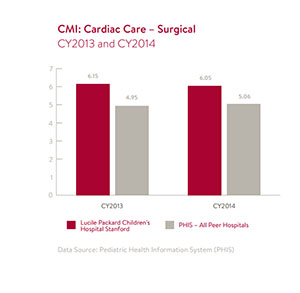According to recent data from the Children’s Hospital Association’s Pediatric Health Information System (PHIS), the Children’s Heart Center at Lucile Packard Children's Hospital Stanford and Stanford Children’s Health has higher marks in key areas — including survival rates and average length of stay — compared with dozens of other children’s and young adult cardiac programs nationwide. What makes these outcomes even more noteworthy is the fact that the Heart Center also has the highest acuity Case Mix Index (CMI) in the country.*
The Children's Heart Center’s survival rates were higher than the national data set for PHIS “peer hospitals”:
View the Observed to Expected Mortality Ratio for Cardiac Service Line chart
When looking specifically at cardiac surgical care, the Children's Heart Center's outcomes were even more impressive:
View the Observed to Expected Mortality Ratio for Cardiac Care - Surgical chart
Adding even more weight to these survival rates is the fact that Lucile Packard Children’s Hospital Stanford handles the highest acuity and complexity cardiac cases in the country:


View the MI: Cardia Care - Surgical chart
View the CMI: Cardia Care - Medical chart
Even while surpassing PHIS peer hospital averages for outcomes, the Heart Center’s average length of stay (ALOS) for both surgical and medical cases was lower than the PHIS national data sets:
View the Case Mix Adj ALOS for Cardiac Care - Surgical chart
View the Case Mix Adj ALOS for Cardiac Care - Medical chart
Due to the Heart Center’s willingness to take on “last hope” cases, a focus on innovation and discovery is a critical part of the equation.
“We learn something new every time we push the limits of what should be achievable,” said Director Stephen Roth, MD, MPH.
* Data Source: Pediatric Health Information System (PHIS), 2013 and 2014. The PHIS hospitals are 46 of the largest and most advanced children's hospitals in America, and constitute the most demanding standards of pediatric service in America. The Children’s Hospital Association developed PHIS to provide a rich data source for clinicians to conduct comparative effectiveness studies that affect hospitalized children.